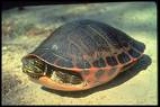
s have named an official state reptile. As with other state symbols, states compare admirable aspects of the reptile and of the state, within designating statutes. They also note historical use or economic benefits from the creature, and discuss how widespread the animal is in the state or how it needs preservation. Schoolchildren often start campaigns promoting their favorite reptile to encourage state legislators to enact it as a state symbol. Many Secretaries of State
maintain educational web pages that describe the state reptile.
Oklahoma was the first state to name an official reptile
, the collared lizard
, in 1969. Only two states followed in the 1970s, but the ensuing decades saw nominations at a rate of almost one per year. State birds are more common, with all fifty states naming one, and they were adopted earlier, with the first one selected in 1927.
Before their formal designation as state reptiles, Florida's alligator
, Maryland's terrapin
, and Texas's horned lizard
were all mascots of a major in-state university. West Virginia's timber rattlesnake was an early American flag element dating back to 1775. Because of their cold-blooded nature, reptiles are more common in warmer climates, and nineteen of the twenty-six state reptiles represent southern states. Six states chose a species named after the state.
A turtle
was chosen by more than half of the states. In all, the most frequently chosen species, with four states naming it, is the painted turtle
. One state reptile, the Alabama red-bellied turtle
is legally designated as an endangered species
in the United States, and several others, also turtles, are threatened at some lesser level.
Legislation
A reptile becomes the official state symbol after it is voted in by the state legislature. Although many states require the bill to be signed by the governor, in some the enabling act is a resolution(legislature vote only). In 2004, Illinois held a popular vote to pick the painted turtle, but legislation was still required in 2005 to make the choice official.
Schoolchildren often start the campaigns for state reptiles. Three of the four states choosing the painted turtle credit school classes with initiating the process. The process may require students to be knowledgeable of their selection, as was the case in Florida when students advocated for the loggerhead sea turtle
; "Working with State Representative Curtis Richardson (D-Tallahassee), the students provided information and answered questions regarding the symbols." In New York, students statewide voted to pick one of four turtles; the common snapping turtle edged the painted turtle 5,048 to 5,005. Assemblyman Joel Miller
had sponsored the turtle election to interest students in politics and said of the results, "as with every election, every vote is important".
Candidate state reptiles are not assured of making it through the legislative process. In Minnesota, 1998 and 1999 bills proposing the Blanding's turtle
were unsuccessful. In Pennsylvania in 2009, the House passed an eastern box turtle bill which died in the Senate without a vote. Virginia proponents of the eastern box turtle have seen 1999 and 2009 bids fail. For the most recent attempt, a legislative opponent of the turtle said it was too cowardly for the state because of its defensive shell, and suggested the rattlesnake
would be a better representative. The turtle also drew scorn for often perishing on roads, but its most serious problem was a too-close association with bordering state, North Carolina.
Justification
Like other state symbols, a state reptile is intended to show state pride. The designation has no economic or wildlife protection effect. States justify their choice of state reptiles, with differing rationales, in designating legislation and on websites:- North Carolina selected the eastern box turtle because its behavior reflects admirable human ideals: "The turtle watches undisturbed as countless generations of faster 'hares' run by to quick oblivion, and is thus a model of patience for mankind, and a symbol of our State’s unrelenting pursuit of great and lofty goals."
- Maryland notes its historical associations with the diamondback terrapin: "Chesapeake colonists ate terrapin prepared Native-American fashion, roasted whole in live coals. Abundant and easy to catch, terrapin were so ample that landowners often fed their slaves and indentured servants a staple diet of terrapin meat. Later, in the 19th century, the turtle was appreciated as gourmet food, especially in a stew laced with cream and sherry."
- Ohio touts the ubiquity and practical benefits of its reptile: "The black racerColuber constrictorColuber constrictor is a species of nonvenomous, colubrid snakes commonly referred to as the eastern racers. They are primarily found throughout the United States, east of the Rocky Mountains, but they range north into Canada, and south into Mexico, Guatemala and Belize...
snake was adopted because it is native to all 88 Ohio counties and is called the 'farmer's friend' because it eats disease-carrying rodents." - Texas stresses the conservation needs of the Texas horned lizard: "It is perhaps most appropriate for designation as an official state symbol because, like many other things truly Texan, it is a threatened species."
Use
The state reptile concept serves education. Some states offer lesson plans using the reptile for teachers to introduce children to the legislative process, discuss state geography, or develop state patriotism. Many Secretaries of State have a "kids page" describing the reptile. Some, such as Missouri's Robin Carnahan, tout state-provided coloring books.
Geography
Perhaps owing to the greater presence of cold-blooded (ectothermic) reptiles in warmer climates, the states in the southern half of the United States have more commonly designated a state reptile. From the twenty-four of the contiguous states roughly south of the Mason–Dixon line, only five lack a state reptile. From east to west, they are Delaware, Virginia, Kentucky, Arkansas, and Utah.
In contrast, in the north half of the central and western states, only one, Wyoming, has named a state reptile. In the Great Lakes
region, there is a cluster of three states (Illinois, Michigan, and Ohio) that named a reptile. In the Northeast
, there is another cluster of three participating states (Massachusetts, New York, and Vermont).
Neither of the noncontiguous states, Alaska and Hawaii, have named a state reptile. The District of Columbia lacks a "state" reptile although it does have an official tree and flower (its only animal symbol is a bird). None of the organized territories of the United States have state reptiles, although all four have designated official flowers.
Six states chose reptiles named after the state. In common name
s, Arizona and Texas were represented by the Arizona ridge-nosed rattlesnake and Texas horned lizard. Mississippi and North Carolina appeared in scientific names
: Alligator mississippiensis and Terrapene carolina carolina. Alabama and New Mexico appeared in both common names (Alabama red-bellied turtle and New Mexico whiptail lizard) and scientific names (Pseudemys alabamensis and Cnemidophorus neomexicanus).
Rate of adoption and comparison to other symbols
In 1969, Oklahoma designated the first state reptile when it chose the collared lizard. Two states followed suit in the 1970s, seven states in the 1980s, eight states in the 1990s, and eight states in the 2000s. As of January 2011, twenty-six of the fifty states have named a state reptile; none has yet been named in the 2010s.In contrast to state reptiles, state birds have been more rapidly adopted, with the first state designating one in 1927 and the fiftieth in 1973. As of January 2011, other types of animals more popular for state symbolization were mammals (46), fish (45), and insects (42). Animal symbols less popular than reptiles were butterflies (17), amphibians (17), dogs (11), dinosaurs (5), bats
(3), and crustaceans (3).
In their almanac of U.S. state symbols, Benjamin and Barbara Shearer spend comparatively little text on state reptiles. They spend a full chapter each on state birds, trees and flowers; within those chapters, they take about a half page to describe the campaign to establish each state's specific symbol. Reptiles, on the other hand, are shown only in list format in a chapter titled "Miscellaneous", where the other non-bird animals (and many non-animals) are listed. Shearer and Shearer consider the state reptiles to be part of a "last thirty years" phenomenon (written in 2003) that includes such particular items as a state's "official beverage".
Politics
Some of the state reptiles have had previous appearances in American politics.
developed an emblem with a coiled rattlesnake with the words "Don't tread on me" on a yellow background. Versions of the Gadsden flag
were used by the Continental Navy's first commodore, early Marines
, and minutemen
and regular army
units in Virginia, Pennsylvania, Rhode Island, and Massachusetts.
The timber rattlesnake is also famous for appearing on the First Navy Jack
, a red and white striped flag. However, although traditionally believed to have been used by the Continental Navy
, recent scholarship asserts that the snake on that jack was a late 19th century invention. Nevertheless, in 1975 and 1776, the U.S. Navy brought back the traditional (snake-showing) jack for the service's bicentennial. After 1980, the oldest commissioned vessel in the U.S. Navy was designated to use the traditional jack. Since 2002, in response to the 9/11 terrorist attacks, the U.S. Navy has all its ships using the First Navy Jack.
West Virginia named the timber rattlesnake as its state reptile in 2008. A 2009 article, "West Virginia's state reptile", in the state wildlife magazine drew a connection to the older American rattlesnake symbol:
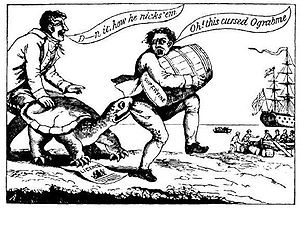
Actually, the warning on the early flags was not meant to depict the timber rattlesnake as being ferocious or the American people as being warlike. The true message was that the citizens of the Colonies were a peaceable and freedom-loving people, but if England’s King George III continued with his oppressive policies toward the Colonies, then they would respond with great wrath. This response would be much like that of a timber rattlesnake, which is peaceable and slow to anger, but will attack aggressively when provoked and will not stop fighting until the enemy retreats.
Benjamin Franklin, writing as an anonymous person, submitted the following statement concerning the disposition of the timber rattlesnake to the Pennsylvania Journal in 1775: “She never begins an attack, nor, when once engaged, ever surrenders: She is therefore an emblem of magnanimity and true courage...she never wounds ‘till she has generously given notice, even to her enemy, and cautioned him against the danger of treading on her."
In contrast to the positive symbology of the rattlesnake, some political use has been for criticism. The snapping turtle (New York) was the central feature of a famous American political cartoon. Published in 1808 in Federalist protest of the Jeffersonian Embargo Act of 1807
, the cartoon showed a snapping turtle, jaws locked fiercely to the rear of an American trader, who was attempting to carry a barrel of goods onto a British ship. The trader was seen whimsically uttering the words "Oh! this cursed Ograbme" (the backwards spelling of "embargo"). Also, during the Great Depression
, the gopher tortoise (Georgia, Florida's official tortoise) was known as the “Hoover chicken” (a sarcastic reference to President Herbert Hoover
) because it was eaten by poor people out of work.
Athletics
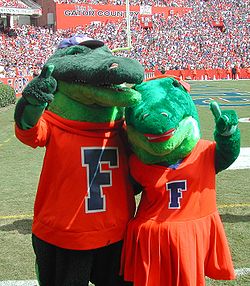
Florida honored the American alligator in 1987, but the Gators
have titled the University of Florida
's teams since 1911. In that year, a printer made a spur-of-the-moment decision to print an alligator emblem on a shipment of the schools football pennants; the mascot stuck, perhaps because the team captain's nickname was Gator.
Maryland honored the diamondback terrapin in 1994, but the mascot of Maryland's main state university in College Park
has been the Terrapins or "Terps"
since 1932. In that year, the football coach, who had encountered the animal as a boy near the Chesapeake Bay
, proposed it as a mascot to oppose the Wildcats, Tigers, and such of enemy teams.
Texas honored the Texas horned lizard in 1993, but private Texas Christian University
has had the associated mascot the Horned Frog
since 1896. According to legend, the football team identified with the lizards found on the practice field as the athletes and reptiles were similarly scrappy. The college founder's son, Addison Clark Jr., a faculty member and the initiator of the football team, had been fascinated by the creatures. By 1897, the lizard appeared as a logo on the front of the school yearbook, which Clark had also started and was managing.
Biology
In terms of common divisions of reptiles, turtles are most popular. Fifteen of the twenty-six states give them official status. The rest of the state reptiles comprise four snakes, four lizard
s, and three crocodilians. Seventeen states name a reptile at the species
level, three a genus
, and seven a subspecies
.
The species most frequently adopted as a state reptile is the painted turtle, with four states designating it: Colorado (the western subspecies), Illinois, Michigan, and Vermont. Three southern states—Florida, Louisiana, and Mississippi—represent themselves with the American alligator. A species of box turtle, Terrapene carolina
or common box turtle, has been chosen by three states, with North Carolina and Tennessee using the Terrapene carolina carolina (eastern box turtle) subspecies, and with Missouri using the Terrapene carolina triungus (three-toed box turtle) subspecies. Two bordering western states, California and Nevada, chose the desert tortoise
. The loggerhead sea turtle was named by South Carolina as state reptile, while Florida chose it as state saltwater reptile. Florida also named an official tortoise, the gopher tortoise, the same animal as Georgia's state reptile.
Four genera ('genuses') are represented with different species in the list. Terrapene (box turtles) has Terrapene ornata
(Kansas) along with Terrapene carolina (Missouri, North Carolina, and Tennessee). Under Gopherus
(gopher tortoises), there are Gopherus polyphemus (Georgia's state reptile and Florida's state tortoise) and Gopherus agassizii (California and Nevada). Under Crotalus
(one of two rattlesnake genera), Arizona named Crotalus willardi willardi, while West Virginia chose Crotalus horridus. With Phrynosoma (horned lizards), Wyoming specified the entire genus, but Texas specified Phrynosoma cornutum.
General reptile declines and state reptile examples
| 1953 Golden Guide | 2001 Golden Guide |
|---|---|
| "As a group [reptiles] are neither 'good' nor 'bad', but are interesting and unusual, although of minor importance. If they should all disappear it would not make much difference one way or the other." | "Reptiles and amphibians are an important part of the environment...They help control harmful pests and are prey for other creatures. Needless killing...must stop. Wild areas...should be preserved." |
Writing in 1988, naturalist J. Whitfield Gibbons
asserted that awareness of the conservation
needs of reptiles had lagged that of large mammals and game species. However, comparison of different editions of the Golden Guide
does show increasing sensitivity to U.S. reptile conservation over the last half of the 20th century.
In their 2000 review article "The global decline of reptiles, deja vu amphibians", Gibbons and colleagues argue that while the general public is more sympathetic to amphibian
s (perhaps because of their soft skin), reptile species are actually more endangered. Although populations can decline from natural causes, and it is difficult to prove the exact reason for a specific reptile's decline, human actions are behind most of the species' problems. Gibbons et al. describe six causes of reptile reductions, incidentally furnishing several examples of state reptile species impacted.
- OverharvestingOverexploitationOverexploitation, also called overharvesting, refers to harvesting a renewable resource to the point of diminishing returns. Sustained overexploitation can lead to the destruction of the resource...
. Overcollection by humans has strongly hurt many reptile species, especially turtles. The diamondback turtle (Maryland), once extremely common, dropped sharply in the beginning of the 20th century because of its popularity in soupTurtle soupTurtle soup is soup or stews made from the flesh of the turtle. The dish exists in many cultures and is viewed as a luxury or delicacy.The green turtle was commonly used for turtle soup in the United States and United Kingdom. Soup made from the snapping turtle was found mainly in the United States...
, but is gradually recovering now that harvesting for food has mostly stopped. Capture for the pet tradeWildlife tradeThe international wildlife trade is a serious conservation problem, addressed by the United Nations' Convention of International Trade in Endangered Species of Wild Fauna and Flora CITES, which currently has 175 member countries called Parties. The 15th meeting of the Parties took place in Doha,...
has been strongly implicated in the decline of box turtles (Kansas, Missouri, North Carolina, Tennessee). The timber rattlesnake (West Virginia) is threatened by "rattlesnake roundups" because females take nine years to mature and only produce four young per year. However, not all reptile usage is unsustainable. Since the late 20th century recovery of the American alligator (Florida, Louisiana, Mississippi), its numbers have been successfully managed by game restrictionsWildlife managementWildlife management attempts to balance the needs of wildlife with the needs of people using the best available science. Wildlife management can include game keeping, wildlife conservation and pest control...
and commercial ranchingAlligator farmAn alligator farm or crocodile farm is an establishment for breeding and raising of crocodilians in order to produce meat, leather, and other goods...
. - Habitat loss. Gopher tortoises (Georgia, Florida's official tortoise) have been impacted by the loss of 97% of the Southeast's longleaf pine forest.
- Introduced invasive speciesInvasive species"Invasive species", or invasive exotics, is a nomenclature term and categorization phrase used for flora and fauna, and for specific restoration-preservation processes in native habitats, with several definitions....
. New plant species have harmed the desert tortoise (California, Nevada) and gopher tortoise (Georgia, Florida's official tortoise). Egg-eating fire ants have reduced the Texas horned lizard (Texas) from part of its range. - Environmental pollution. Water pollution is primarily seen in turtles and crocodilians and can affect their eggs and sex characteristics. Male American alligators (Florida, Louisiana, Mississippi) have been found with lowered testosterone and altered gonads in a chemically contaminated lake.
- DiseaseDiseaseA disease is an abnormal condition affecting the body of an organism. It is often construed to be a medical condition associated with specific symptoms and signs. It may be caused by external factors, such as infectious disease, or it may be caused by internal dysfunctions, such as autoimmune...
. Increased disease in wild populations often follows weakening from other environmental stressors, such as habitat loss. Upper lung infection and shell diseases have been implicated in the decline of the desert tortoise (California, Nevada) and gopher tortoise (Georgia, Florida's state tortoise). - Global warmingEffects of climate change on terrestrial animalsClimate change has had a significant direct effect on terrestrial animals, by being a major driver of the processes of speciation and extinction. The best known example of this is the Carboniferous Rainforest Collapse which occurred 350 million years ago...
represents a future threat by changing habitat. Reptiles are more unsafe than birds because they have less ability to move large distances. Gibbons and colleagues do not describe any examples of impact on specific state reptile species, although they mention a general concern for turtles and crocodillians having their populations become imbalanced—the animals sexes are determined by temperature of the eggsTemperature-dependent sex determinationTemperature-dependent sex determination is type of environmental sex determination in which the temperatures experienced during embryonic development determine the sex of the offspring. It is most prevalent and common among amniote vertebrates that are classified under the reptile class, but is...
.
IUCN ratings
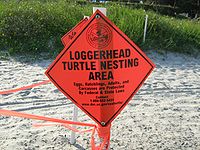
, going from Extinct to Least Concern. None of the U.S. state reptiles are in the most extreme categories of Extinct, Extinct in the Wild, or Critically Endangered. Two species are IUCN Endangered: the Alabama red-bellied turtle (Alabama) and the loggerhead sea turtle (South Carolina, also the state saltwater reptile of Florida). However, in the United States, only the Alabama red-bellied turtle is legally an endangered species
. The loggerhead sea turtle is only considered "threatened" under U.S. regulations.
Two species are IUCN Vulnerable: the desert tortoise (California and Nevada) and the gopher tortoise (Georgia, also the official tortoise of Florida). Three species are Near Threatened: the diamondback terrapin (Maryland), the ornate box turtle (Kansas), and the common box turtle (Missouri with the three-toed subspecies, North Carolina and Tennessee with the eastern subspecies). All the remaining state reptile species are Least Concern. Interestingly, all the non-turtle reptiles fall into this category, but the only two turtles in relative safety are the common snapping turtle (New York) and the painted turtle (Colorado, Illinois, Michigan, Vermont).
The tabulated IUCN ratings
for the state reptiles all reflect species-level assessments; for most state reptiles, the IUCN does not discuss the subspecies situations. With the Arizona ridge-backed rattlesnake, the IUCN notes the subspecies has similar safety to the overall species, but does not formally rate the subspecies.
The ratings also do not reflect state-specific population conditions. For instance, for the Texas horned lizard, much of eastern Texas has lost the animal. Nevertheless, based on healthy populations in other parts of the West, especially New Mexico, the IUCN rates the animal Least Concern. For the timber rattlesnake (West Virginia), the IUCN notes the animal as losing range in many parts of the northeastern U.S., but because the animal is numerous in the southern Appalachians, it is also Least Concern.
The IUCN status of state reptiles at the genus level is ambiguous. For Massachusetts's garter snake
, the listed Least Concern represents the status of the pictured common garter snake
, the species found throughout much of North America and residing in Massachusetts. Within that genus, there are twenty-three species at Least Concern and two each at Vulnerable, Endangered and Data Deficient. For Oklahoma's collared lizard state reptile, the rating reflects that of the pictured common collared lizard
, which ranges over much of western North America and resides in Oklahoma. Within that genus, there are eight Least Concern, one Vulnerable, and one Endangered species. For Wyoming's horned lizard state reptile, the rating reflects that of the pictured short-horned lizard
, which occurs over much of the central United States and almost all of Wyoming. Within that genus, there are ten species at Least Concern and one at Near Threatened and one at Data Deficient.
State reptiles
| State | State reptile | Scientific name | Year adopted | Conservation status | Photograph | References |
|---|---|---|---|---|---|---|
| Alabama Alabama Alabama is a state located in the southeastern region of the United States. It is bordered by Tennessee to the north, Georgia to the east, Florida and the Gulf of Mexico to the south, and Mississippi to the west. Alabama ranks 30th in total land area and ranks second in the size of its inland... |
Alabama red-bellied turtle Alabama red-bellied turtle The Alabama red-bellied turtle, Pseudemys alabamensis, or Alabama red-bellied cooter is native to Alabama. It belongs to the Emydidae turtle family. It is the official reptile of the state of Alabama.-Life History:... |
Pseudemys alabamensis | 1990 | |||
| Arizona Arizona Arizona ; is a state located in the southwestern region of the United States. It is also part of the western United States and the mountain west. The capital and largest city is Phoenix... |
Arizona ridge-nosed rattlesnake | Crotalus willardi subspecies willardi |
1986 | |||
| California California California is a state located on the West Coast of the United States. It is by far the most populous U.S. state, and the third-largest by land area... |
Desert tortoise Desert Tortoise The desert tortoise is a species of tortoise native to the Mojave desert and Sonoran desert of the southwestern United States and northwestern Mexico. They can be located in western Arizona, southeastern California, southern Nevada, and southwestern Utah. The species name agassizii is in honor of... |
Gopherus agassizii | 1972 | 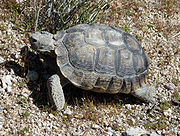 |
||
| Colorado Colorado Colorado is a U.S. state that encompasses much of the Rocky Mountains as well as the northeastern portion of the Colorado Plateau and the western edge of the Great Plains... |
Western painted turtle | Chrysemys picta subspecies belli |
2008 | |||
| Florida Florida Florida is a state in the southeastern United States, located on the nation's Atlantic and Gulf coasts. It is bordered to the west by the Gulf of Mexico, to the north by Alabama and Georgia and to the east by the Atlantic Ocean. With a population of 18,801,310 as measured by the 2010 census, it... |
American alligator American Alligator The American alligator , sometimes referred to colloquially as a gator, is a reptile endemic only to the Southeastern United States. It is one of the two living species of alligator, in the genus Alligator, within the family Alligatoridae... (state reptile) |
Alligator mississippiensis | 1987 | 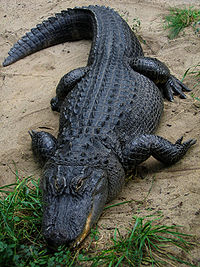 |
||
| Florida Florida Florida is a state in the southeastern United States, located on the nation's Atlantic and Gulf coasts. It is bordered to the west by the Gulf of Mexico, to the north by Alabama and Georgia and to the east by the Atlantic Ocean. With a population of 18,801,310 as measured by the 2010 census, it... |
Loggerhead sea turtle Loggerhead sea turtle The loggerhead sea turtle , or loggerhead, is an oceanic turtle distributed throughout the world. It is a marine reptile, belonging to the family Cheloniidae. The average loggerhead measures around long when fully grown, although larger specimens of up to have been discovered... (state saltwater reptile) |
Caretta caretta | 2008 | |||
| Florida Florida Florida is a state in the southeastern United States, located on the nation's Atlantic and Gulf coasts. It is bordered to the west by the Gulf of Mexico, to the north by Alabama and Georgia and to the east by the Atlantic Ocean. With a population of 18,801,310 as measured by the 2010 census, it... |
Gopher tortoise (state tortoise) |
Gopherus polyphemus | 2008 | 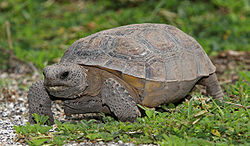 |
||
| Georgia Georgia (U.S. state) Georgia is a state located in the southeastern United States. It was established in 1732, the last of the original Thirteen Colonies. The state is named after King George II of Great Britain. Georgia was the fourth state to ratify the United States Constitution, on January 2, 1788... |
Gopher tortoise | Gopherus polyphemus | 1989 |  |
||
| Illinois Illinois Illinois is the fifth-most populous state of the United States of America, and is often noted for being a microcosm of the entire country. With Chicago in the northeast, small industrial cities and great agricultural productivity in central and northern Illinois, and natural resources like coal,... |
Painted turtle Painted Turtle The painted turtle is the most widespread native turtle of North America. It lives in slow-moving fresh waters, from southern Canada to Louisiana and northern Mexico, and from the Atlantic to the Pacific. The turtle is the only species of the genus Chrysemys, which is part of the pond turtle... |
Chrysemys picta | 2005 | |||
| Kansas Kansas Kansas is a US state located in the Midwestern United States. It is named after the Kansas River which flows through it, which in turn was named after the Kansa Native American tribe, which inhabited the area. The tribe's name is often said to mean "people of the wind" or "people of the south... |
Ornate box turtle Terrapene ornata Terrapene ornata is a species of North American box turtle sometimes referred to as the western box turtle or ornate box turtle.- Taxonomy :There are two subspecies of T. ornata:... |
Terrapene ornata | 1986 | |||
| Louisiana Louisiana Louisiana is a state located in the southern region of the United States of America. Its capital is Baton Rouge and largest city is New Orleans. Louisiana is the only state in the U.S. with political subdivisions termed parishes, which are local governments equivalent to counties... |
American alligator American Alligator The American alligator , sometimes referred to colloquially as a gator, is a reptile endemic only to the Southeastern United States. It is one of the two living species of alligator, in the genus Alligator, within the family Alligatoridae... |
Alligator mississippiensis | 1983 |  |
||
| Maryland Maryland Maryland is a U.S. state located in the Mid Atlantic region of the United States, bordering Virginia, West Virginia, and the District of Columbia to its south and west; Pennsylvania to its north; and Delaware to its east... |
Diamondback terrapin Diamondback terrapin The diamondback terrapin or simply terrapin, is a species of turtle native to the brackish coastal swamps of the eastern and southern United States. It belongs to the monotypic genus, Malaclemys... |
Malaclemys terrapin | 1994 | 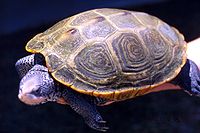 |
||
| Massachusetts Massachusetts The Commonwealth of Massachusetts is a state in the New England region of the northeastern United States of America. It is bordered by Rhode Island and Connecticut to the south, New York to the west, and Vermont and New Hampshire to the north; at its east lies the Atlantic Ocean. As of the 2010... |
Garter snake Garter snake The Garter snake is a Colubrid snake genus common across North America, ranging from Alaska and Canada to Central America. It is the single most widely distributed genus of reptile in North America. The garter snake is also the Massachusettsstate reptile.There is no real consensus on the... |
Thamnophis (whole genus) |
2006 | |||
| Michigan Michigan Michigan is a U.S. state located in the Great Lakes Region of the United States of America. The name Michigan is the French form of the Ojibwa word mishigamaa, meaning "large water" or "large lake".... |
Painted turtle Painted Turtle The painted turtle is the most widespread native turtle of North America. It lives in slow-moving fresh waters, from southern Canada to Louisiana and northern Mexico, and from the Atlantic to the Pacific. The turtle is the only species of the genus Chrysemys, which is part of the pond turtle... |
Chrysemys picta | 1995 | |||
| Mississippi Mississippi Mississippi is a U.S. state located in the Southern United States. Jackson is the state capital and largest city. The name of the state derives from the Mississippi River, which flows along its western boundary, whose name comes from the Ojibwe word misi-ziibi... |
American alligator American Alligator The American alligator , sometimes referred to colloquially as a gator, is a reptile endemic only to the Southeastern United States. It is one of the two living species of alligator, in the genus Alligator, within the family Alligatoridae... |
Alligator mississippiensis | 2005 |  |
||
| Missouri Missouri Missouri is a US state located in the Midwestern United States, bordered by Iowa, Illinois, Kentucky, Tennessee, Arkansas, Oklahoma, Kansas and Nebraska. With a 2010 population of 5,988,927, Missouri is the 18th most populous state in the nation and the fifth most populous in the Midwest. It... |
Three-toed box turtle | Terrapene carolina subspecies triunguis |
2007 | 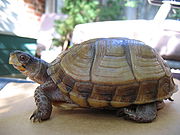 |
||
| Nevada Nevada Nevada is a state in the western, mountain west, and southwestern regions of the United States. With an area of and a population of about 2.7 million, it is the 7th-largest and 35th-most populous state. Over two-thirds of Nevada's people live in the Las Vegas metropolitan area, which contains its... |
Desert tortoise Desert Tortoise The desert tortoise is a species of tortoise native to the Mojave desert and Sonoran desert of the southwestern United States and northwestern Mexico. They can be located in western Arizona, southeastern California, southern Nevada, and southwestern Utah. The species name agassizii is in honor of... |
Gopherus agassizii | 1989 |  |
||
| New Mexico New Mexico New Mexico is a state located in the southwest and western regions of the United States. New Mexico is also usually considered one of the Mountain States. With a population density of 16 per square mile, New Mexico is the sixth-most sparsely inhabited U.S... |
New Mexico whiptail lizard | Cnemidophorus neomexicanus | 2003 | |||
| New York New York New York is a state in the Northeastern region of the United States. It is the nation's third most populous state. New York is bordered by New Jersey and Pennsylvania to the south, and by Connecticut, Massachusetts and Vermont to the east... |
Common snapping turtle | Chelydra serpentina | 2006 | |||
| North Carolina North Carolina North Carolina is a state located in the southeastern United States. The state borders South Carolina and Georgia to the south, Tennessee to the west and Virginia to the north. North Carolina contains 100 counties. Its capital is Raleigh, and its largest city is Charlotte... |
Eastern box turtle Terrapene carolina carolina The eastern box turtle is a subspecies within a group of hinge-shelled turtles, normally called box turtles. T. c. carolina is native to an eastern part of the United States.... |
Terrapene carolina subspecies carolina |
1979 | |||
| Ohio Ohio Ohio is a Midwestern state in the United States. The 34th largest state by area in the U.S.,it is the 7th‑most populous with over 11.5 million residents, containing several major American cities and seven metropolitan areas with populations of 500,000 or more.The state's capital is Columbus... |
Northern black racer Coluber constrictor Coluber constrictor is a species of nonvenomous, colubrid snakes commonly referred to as the eastern racers. They are primarily found throughout the United States, east of the Rocky Mountains, but they range north into Canada, and south into Mexico, Guatemala and Belize... |
Coluber constrictor subspecies constrictor |
1995 | 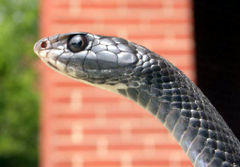 |
||
| Oklahoma Oklahoma Oklahoma is a state located in the South Central region of the United States of America. With an estimated 3,751,351 residents as of the 2010 census and a land area of 68,667 square miles , Oklahoma is the 28th most populous and 20th-largest state... |
Common collared lizard Common Collared Lizard The Common collared lizard, Oklahoma collared lizard or collared lizard, Crotaphytus collaris, is a North American lizard that can reach a foot long in length , with a large head and powerful jaws. They are well known for the ability to run on their hind legs, looking like small dinosaurs... |
Crotaphytus (whole genus) |
1969 | |||
| South Carolina South Carolina South Carolina is a state in the Deep South of the United States that borders Georgia to the south, North Carolina to the north, and the Atlantic Ocean to the east. Originally part of the Province of Carolina, the Province of South Carolina was one of the 13 colonies that declared independence... |
Loggerhead sea turtle Loggerhead sea turtle The loggerhead sea turtle , or loggerhead, is an oceanic turtle distributed throughout the world. It is a marine reptile, belonging to the family Cheloniidae. The average loggerhead measures around long when fully grown, although larger specimens of up to have been discovered... |
Caretta caretta | 1988 | |||
| Tennessee Tennessee Tennessee is a U.S. state located in the Southeastern United States. It has a population of 6,346,105, making it the nation's 17th-largest state by population, and covers , making it the 36th-largest by total land area... |
Eastern box turtle Terrapene carolina carolina The eastern box turtle is a subspecies within a group of hinge-shelled turtles, normally called box turtles. T. c. carolina is native to an eastern part of the United States.... |
Terrapene carolina subspecies carolina |
1995 | |||
| Texas Texas Texas is the second largest U.S. state by both area and population, and the largest state by area in the contiguous United States.The name, based on the Caddo word "Tejas" meaning "friends" or "allies", was applied by the Spanish to the Caddo themselves and to the region of their settlement in... |
Texas horned lizard Texas horned lizard The Texas horned lizard is one of about 14 North American species of spikey-bodied reptiles called horned lizards. P. cornutum ranges from Colorado and Kansas to northern Mexico , and from southeastern Arizona to Texas. There are also isolated, introduced populations in the Carolinas, Georgia, and... |
Phrynosoma cornutum | 1993 | |||
| Vermont Vermont Vermont is a state in the New England region of the northeastern United States of America. The state ranks 43rd in land area, , and 45th in total area. Its population according to the 2010 census, 630,337, is the second smallest in the country, larger only than Wyoming. It is the only New England... |
Painted turtle Painted Turtle The painted turtle is the most widespread native turtle of North America. It lives in slow-moving fresh waters, from southern Canada to Louisiana and northern Mexico, and from the Atlantic to the Pacific. The turtle is the only species of the genus Chrysemys, which is part of the pond turtle... |
Chrysemys picta | 1994 | |||
| West Virginia West Virginia West Virginia is a state in the Appalachian and Southeastern regions of the United States, bordered by Virginia to the southeast, Kentucky to the southwest, Ohio to the northwest, Pennsylvania to the northeast and Maryland to the east... |
Timber rattlesnake Crotalus horridus Crotalus horridus, the timber rattlesnake, is a species of venomous pitviper found in the eastern United States. This is the only rattlesnake species in most of the populous northeastern United States. No subspecies are currently recognized.... |
Crotalus horridus | 2008 | |||
| Wyoming Wyoming Wyoming is a state in the mountain region of the Western United States. The western two thirds of the state is covered mostly with the mountain ranges and rangelands in the foothills of the Eastern Rocky Mountains, while the eastern third of the state is high elevation prairie known as the High... |
Horned lizard Horned lizard Horned lizards are a genus of lizards which are the type genus of the family Phrynosomatidae. The horned lizard is popularly called a "horned toad", "horny toad", or "horned frog", but it is neither a toad nor a frog. The popular names come from the lizard's rounded body and blunt snout, which... |
Phrynosoma (whole genus) |
1993 | 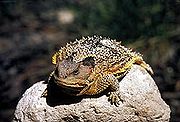 |

